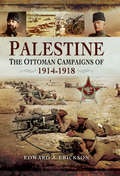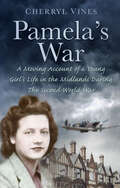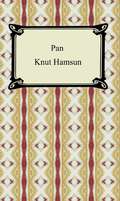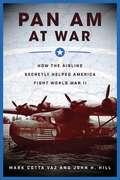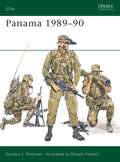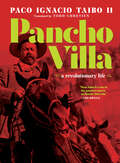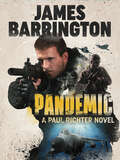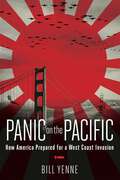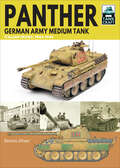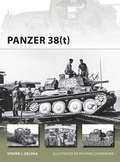- Table View
- List View
Palestine: The Ottoman Campaigns of, 1914–1918
by Edward J. EricksonThe campaigns fought by the Ottomans against the British in Palestine are often neglected in accounts of the Great War, yet they are fascinating from the point of view of military history and critically important because of their impact upon the modern Middle East. Edward Erickson's authoritative and absorbing account of the four-year struggle for control of Palestine between 1914 and 1918 of the battles fought for Suez, Sinai, Gaza, Jordan and Syria opens up this little-understood aspect of the global conflict and it does so in a strikingly original way, by covering the fighting from the Ottoman perspective. Using Turkish official histories and military archives, he recounts the entire course of the campaigns, from the initial attack by German-led Ottoman forces on Sinai and the Suez Canal, the struggle for Gaza and the outbreak of the Arab Revolt to the British offensives, the battle for Jerusalem, the Ottoman defeat at Megiddo and the rapid British advance which led to the capture of Damascus and Aleppo in 1918.
Palgrave Advances in Modern Military History
by Matthew Hughes William J. PhilpottThis collection constitutes the definitive guide for advanced undergraduate and postgraduate students studying modern military history. It provides the reader with a clear and up-to-date survey of the significant debates, interpretations and historiographical shifts for a series of key themes in military history, ranging from the fifteenth to the twenty-first centuries, and across the technological, political, social, and cultural dimensions of military history.
Palm Beach County During World War II (Images of America)
by Susan Gillis Richard A. Marconi Debi MurrayDuring World War II, Palm Beach County was a beehive of activity. Beachgoers witnessed the destruction left in the wake of U-boat attacks and then helped rescue survivors and retrieve the dead. One of the first Civil Air Patrol units to hunt German U-boats operated from Palm Beach County. Morrison Field in West Palm Beach served as the take-off point for Army Air Corps planes destined for battle lines throughout the world. Boca Raton Army Air Field was the headquarters for training airmen in top-secret RADAR technology. The US Army, Navy, and Coast Guard used resort hotels for training sites and hospitals.
Pals on the Somme 1916: Kitchener's New Army Battalions Raised By Local Authorities During The Great War
by Roni WilkinsonPals on the Somme covers the history of all the Pals Battalions who fought on the Somme during the First World War. The book looks at the events which led to the war and how the Pals phenomenon was born.It considers the attitude and social conditions in Britain at the time. It covers the training and equipping of the Battalions, the preparations for the Big Push, 1st July 1916, and going over the top, and how each battalion fared, failed or succeeded. It looks at how they Battalions had to undergo a change after the 1st July, due to the heavy casualties, and the final victory in 1918, and how the battalions were eventually amalgamated. The final chapter examines how each area coped in the aftermath of losing their men in the three year slaughter. It covers the organizations and visits to the Battlefields as they are today.
Pamela's War: A Moving Account of a Young Girl's Life in the Midlands During the Second World War
by Cherryl VinesIt is the third of September 1939. It is just after half past eleven in the morning. I am fifteen years and sixteen days old. The radiogram at my home, the Woodman Hotel in Clent, has just been switched off, the silence resonates around the room, and a deathly hush has fallen. The Prime Minister, Neville Chamberlain, has declared that, despite the best efforts of the politicians of the day to secure ‘peace in our time’, the inevitable has befallen us; despite pledges to the contrary, Germany has invaded Poland, Hitler has ignored requests to back down and so, therefore, ‘Britain is now at war with Germany’. Minutes after the broadcast ends, my Father, Sidney Wheeler, goes quietly up to his room where he methodically loads three bullets into his First World War revolver. This is the true story of a fifteen-year-old girl’s experience of the Second World War, based around her parent’s hotel in a sleepy Worcestershire village. As war is declared, her father prepares three bullets for the invasion. He will shoot the family and himself when the Germans come. In their village, local Germans are imprisoned (guilty or not). The blackout is immediate and has tragic consequences. There is a court case over an alleged poker game. An abortion nearly results in tragedy. Handsome young airmen fly low over the hotel. Pamela has a premonition of death. The business fails. An air raid very nearly kills them all. She is called up first to factory work and then to the Land Army. She marries by special licence. As the war comes to an end she is living at home with her parents and a small baby, at which point she is just twenty-one years of age. Amusing and entertaining, surprising and often moving, Pamela's account vividly captures one family’s life on the home front in Worcestershire.
Pan
by Knut Hamsun W. W. WorsterOne of Knut Hamsun's most famous works, "Pan" is the story of Lieutenant Thomas Glahn, an ex-military man who lives alone in the woods with his faithful dog Aesop. Glahn's life changes when he meets Edvarda, a merchant's daughter, whom he quickly falls in love with. She, however, is not entirely faithful to him, which affects him profoundly. "Pan" is a fascinating study in the psychological impact of unrequited love and helped to win the Nobel Prize in Literature for Hamsun.
Pan Am at War: How the Airline Secretly Helped America Fight World War II
by Mark Cotta Vaz Hill John H.Pan Am at War chronicles the airline?s historic role in advancing aviation and serving America?s national interest before and during World War II. From its inception, Pan American Airways operated as the ?wings of democracy,? spanning six continents and placing the country at the leading edge of international aviation. At the same time, it was clandestinely helping to fight America?s wars. Utilizing government documents, declassified Freedom of Information Act material, and company documents, the authors have uncovered stories of Pan Am?s stunning role as an instrument of American might:The airline?s role in building air bases in Latin America and countering Axis interests that threatened the Panama CanalCreating transatlantic and trans-Africa supply lines for sending Lend-Lease equipment to BritainCooperation with Chiang Kai-shek and the Chinese nationalist government to pioneer the dangerous ?Hump? route over the Himalayas The dangerous seventeen-thousand-mile journey that took President Roosevelt to the high-stakes Casablanca Conference with Winston ChurchillThe daring flight that delivered uranium for the atomic bomb. Filled with larger-than-life characters, and revelations of the vision and technology it took to dominate the skies, Pan Am at War provides a gripping unknown history of the American Century.
Panama 1989-90
by Gordon Rottman Ronald VolstadIn December 1989 US Army forces, supported by the US Air Force and US Navy, participated in Operation 'Just Cause'--the invasion of Panama. A combination of airborne, helicopter and ground assaults quickly secured key objectives and eliminated organized resistance. Beginning with a brief history of US-Panama relations and the development of the Panamanian Defense Forces, this book focuses principally on the military aspects of Operation 'Just Cause', and ends with a summary of the conflict's aftermath. Numerous photographs, and detailed color plates depict the actions of the armed forces units that executed this difficult, and controversial, operation.
Panavia Tornado: Strike, Anti-Ship, Air Superiority, Air Defence, Reconnaissance & Electronic Warfare Fighter Bomber (Profiles of Flight)
by Martin W. Bowman Dave WindleThe Tornado has been the backbone of the RAF within its many different theaters of operation. The aircraft started as a European venture between Germany, Italy and the UK, based on the original swing-wing technology invented by Barnes-Wallis. It has also been successfully exported to several Middle-Eastern air forces. It is likely to remain in service for several years to come.This book contains the world famous color profiles created by Dave Windle of the type in different operational modes, configurations and color schemes. Martin Bowman has written detailed descriptions and photographs to create the perfect enthusiasts reference.
Pancho Villa: A Revolutionary Life
by Paco Ignacio Taibo IIA wild ride and revealing portrait of the controversial Pancho Villa, one of Mexico&’s most beloved (or loathed) heroes, that finally establishes the importance of his role in the triumph of the Mexican Revolution, by renowned writer Paco Ignacio Taibo II.The last biography of Pancho Villa was published 25 years ago, and this new edition has been translated into English for the first time. This biography marks a kind of reinvention of the legendary Mexican figure of Pancho Villa. It is a masterful reevaluation and heavily researched account of his life. This book makes a new claim, finally giving Pancho Villa his due as the decisive figure in the success of Mexican Revolution. Here he is less the colorful bandito and more the incorruptible conscience that not only won key battles, but also maintained the revolutionary vision and led the way in terms of class consciousness.Pancho Villa is a rollicking, sometimes hilariously comical, sometimes extremely violent, and always very personal portrait of the controversial Mexican historical figure Pancho Villa. Beloved crime writer Paco Ignacio Taibo II (a.k.a. PIT)—the prolific historian, biographer of Che Guevara and the founder of Mexican &“neopolicial&” fiction—brings his tremendous storytelling skills to an account of one of the Mexico&’s greatest legendary characters.With his vibrant narrative style, Taibo describes the adventures of Pancho Villa with incredible stories, the stuff of history and tragedy, backed up by tremendous research. Throughout, Taibo unveils secrets about the life of one of Mexico's most courageous and charismatic leaders. Includes period photographs that indelibly capture the rocky transition from the wild and agrarian past towards modern statehood.
Pandemic (Agent Paul Richter Thriller)
by James BarringtonEliminate everyone who knows...Off the island of Crete an illicit diver finds a 30-year-old aircraft on the seabed. He recovers a steel case containing four sealed flasks from amongst the corpses still trapped inside. Within twelve hours he succumbs to a hideous death.Agency trouble-shooter Paul Richter is sent to investigate, but encounters far more questions than answers. Why has the CIA ordered the total destruction of the aircraft’s remnants? Why is a hit team roaming the island? Who is targeting members of the hit team itself? And why are retired agents back in America facing professional assassination?As Richter gets ever-closer to unravelling a decades-old secret, even he is unprepared for the sheer horror that awaits.James Barrington continues the Paul Richter series in this nail-biting techno-thriller for fans of Chris Ryan, David Baldacci and Robert Ludlum.
Pandemic (An Agent Paul Richter Thriller)
by James BarringtonEliminate everyone who knows...Off the island of Crete an illicit diver finds a 30-year-old aircraft on the seabed. He recovers a steel case containing four sealed flasks from amongst the corpses still trapped inside. Within twelve hours he succumbs to a hideous death.Agency trouble-shooter Paul Richter is sent to investigate, but encounters far more questions than answers. Why has the CIA ordered the total destruction of the aircraft’s remnants? Why is a hit team roaming the island? Who is targeting members of the hit team itself? And why are retired agents back in America facing professional assassination?As Richter gets ever-closer to unravelling a decades-old secret, even he is unprepared for the sheer horror that awaits.James Barrington continues the Paul Richter series in this nail-biting techno-thriller for fans of Chris Ryan, David Baldacci and Robert Ludlum.
Pandemic 1918: Eyewitness Accounts from the Greatest Medical Holocaust in Modern History
by Catharine ArnoldBefore AIDS or coronavirus, there was the Spanish Flu — Catharine Arnold's gripping narrative, Pandemic 1918, marks the 100th anniversary of an epidemic that altered world history. In January 1918, as World War I raged on, a new and terrifying virus began to spread across the globe. In three successive waves, from 1918 to 1919, influenza killed more than 50 million people. German soldiers termed it Blitzkatarrh, British soldiers referred to it as Flanders Grippe, but world-wide, the pandemic gained the notorious title of “Spanish Flu”. Nowhere on earth escaped: the United States recorded 550,000 deaths (five times its total military fatalities in the war) while European deaths totaled over two million. Amid the war, some governments suppressed news of the outbreak. Even as entire battalions were decimated, with both the Allies and the Germans suffering massive casualties, the details of many servicemen’s deaths were hidden to protect public morale. Meanwhile, civilian families were being struck down in their homes. The City of Philadelphia ran out of gravediggers and coffins, and mass burial trenches had to be excavated with steam shovels. Spanish Flu conjured up the specter of the Black Death of 1348 and the great plague of 1665, while the medical profession, shattered after five terrible years of conflict, lacked the resources to contain and defeat this new enemy. Through primary and archival sources, historian Catharine Arnold gives readers the first truly global account of the terrible epidemic.
Pandora’s Box: A History of the First World War
by Jörn LeonhardIn this monumental history of the First World War, Germany’s leading historian of the twentieth century’s first great catastrophe explains the war’s origins, course, and consequences. With an unrivaled combination of depth and global reach, Pandora’s Box reveals how profoundly the war shaped the world to come. Jörn Leonhard treats the clash of arms with a sure feel for grand strategy, the everyday tactics of dynamic movement and slow attrition, the race for ever more destructive technologies, and the grim experiences of frontline soldiers. But the war was much more than a military conflict, or an exclusively European one. Leonhard renders the perspectives of leaders, intellectuals, artists, and ordinary men and women on diverse home fronts as they grappled with the urgency of the moment and the rise of unprecedented political and social pressures. And he shows how the entire world came out of the war utterly changed. Postwar treaties and economic turbulence transformed geopolitics. Old empires disappeared or confronted harsh new constraints, while emerging countries struggled to find their place in an age of instability. At the same time, sparked and fueled by the shock and suffering of war, radical ideologies in Europe and around the globe swept away orders that had seemed permanent, to establish new relationships among elites, masses, and the state. Heralded on its publication in Germany as a masterpiece of historical narrative and analysis, Pandora’s Box makes clear just what dangers were released when the guns first fired in the summer of 1914.
Pandora’s Box: A History of the First World War
by Jörn LeonhardWinner of the Norman B. Tomlinson, Jr. Prize “The best large-scale synthesis in any language of what we currently know and understand about this multidimensional, cataclysmic conflict.” —Richard J. Evans, Times Literary Supplement In this monumental history of the First World War, Germany’s leading historian of the period offers a dramatic account of its origins, course, and consequences. Jörn Leonhard treats the clash of arms with a sure feel for grand strategy. He captures the slow attrition, the race for ever more destructive technologies, and the grim experiences of frontline soldiers. But the war was more than a military conflict and he also gives us the perspectives of leaders, intellectuals, artists, and ordinary men and women around the world as they grappled with the urgency of the moment and the rise of unprecedented political and social pressures. With an unrivaled combination of depth and global reach, Pandora’s Box reveals how profoundly the war shaped the world to come. “[An] epic and magnificent work—unquestionably, for me, the best single-volume history of the war I have ever read…It is the most formidable attempt to make the war to end all wars comprehensible as a whole.” —Simon Heffer, The Spectator “[A] great book on the Great War…Leonhard succeeds in being comprehensive without falling prey to the temptation of being encyclopedic. He writes fluently and judiciously.” —Adam Tooze, Die Zeit “Extremely readable, lucidly structured, focused, and dynamic…Leonhard’s analysis is enlivened by a sharp eye for concrete situations and an ear for the voices that best convey the meaning of change for the people and societies undergoing it.” —Christopher Clark, author of The Sleepwalkers
Panic on the Pacific: How America Prepared for the West Coast Invasion
by Bill YenneThe aftershocks of the December 7, 1941 attack on Pearl Harbor were felt keenly all over America-the war in Europe had hit home. But nowhere was American life more immediately disrupted than on the West Coast, where people lived in certain fear of more Japanese attacks. From that day until the end of the war, a dizzying mix of battle preparedness and rampant paranoia swept the states. Japanese immigrants were herded into internment camps. Factories were camouflaged to look like small towns. The Rose Bowl was moved to North Carolina. Airport runways were so well hidden even American pilots couldn't find them. There was panic on the Pacific coast: the Japanese were coming.
Panther
by Mike GreenThe German Panther tank was almost certainly the most elegant design of WWII. It embodied a balance of firepower, armor protection, and mobility unmatched by any other tank of the period. Yet, it was not the war-winner it might have been. Author Mike Green examines the disparity between the potential of the Panther design and the actuality of the fielded Panther tank in his new book. Though many viewed the Panther as an engineering masterpiece and a technological breakthrough, the Panther failed to meet expectations on the battlefield, thereby crushing Hitler's dreams of world domination. Green explores the evolution--and devolution--of the Panther, providing keen insight and new reasons for its ultimate failure.
Panther German Army Medium Tank: Italian Front, 1944–1945 (TankCraft)
by Dennis OliverThe Allied invasions of Sicily and the Italian mainland had been met with tenacious resistance by the Germans but the defense consisted for the most part of armored units that were little different to those the British had faced in North Africa. But in early 1944, with the landings at Anzio and Nettuno and the attempt to bypass the German defensive line, the Wehrmacht’s high command began shipping heavier and more powerful tanks to the Southern Front including an increasing number Tigers and Panthers. The initial models of the latter had gone into combat for the first time in July 1943 and it was planned that every Panzer regiment would eventually contain a battalion of these impressive vehicles. Drawing on official documentation and unit histories Dennis Oliver investigates the formations that operated these deservedly famous vehicles and uses archive photos and extensively researched color illustrations to examine the markings, camouflage and technical aspects of the Pzkpfw V tanks that wee an integral part of the German defense of the Italian peninsula. A key section of his book displays available model kits and aftermarket products, complemented by a gallery of beautifully constructed and painted models in various scales. Technical details as well as modifications introduced during production and in the field are also examined, providing everything the modeler needs to recreate an accurate representation of these historic vehicles.
Panther Medium Tank 1942-45
by Jim Laurier Stephen HartThe Panzerkampfwagen V Panther is one of the best-known German tanks in existence and is considered one of the greatest tanks of World War II. When in June of 1941, Germany invaded Russia, Panzertruppe encountered KV series and T-34/76 tanks, far superior in firepower and armour protection to any Panzer in service at the time. It was therefore decided to design a new more powerful medium tank, which could be quickly put into production. This book details the result, the Medium Battle Tank, available for service in January 1943. Later models ensured that it became one of the most feared tanks of WWII.
Panther Medium Tank: German Army and Waffen SS Eastern Front Summer, 1943
by Dennis OliverIn July 1943 the German army launched what was to be its last major offensive on Soviet soil. Codenamed Operation Citadel, the attack had initially been scheduled to commence in May but was postponed by Hitler on a number of occasions to allow the divisions in the East to be reinforced and to ensure that the new Panther tanks could be deployed. In the fifth book on the Panther in this series Dennis Oliver examines the first vehicles that left the assembly plants to go into service against the Red Army as part of Operation Citadel and the units that arrived in the late summer and early autumn of 1943. In addition to archive photographs and painstakingly researched, exquisitely presented color illustrations, a large part of this book showcases available model kits and aftermarket products, complemented by a gallery of beautifully constructed and painted models in various scales. Technical details as well as modifications introduced during production and in the field are also examined, providing everything the modeller needs to recreate an accurate representation of the Panther tanks that fought in the East in 1943.
Panther Medium Tank: IV. SS-Panzerkorps Eastern Front, 1944 (TankCraft)
by Dennis OliverDuring the summer of 1944 a series of massive Soviet offensives threatened to destroy the entire German army on the Eastern Front. As the Wehrmacht scrambled to hold what ground it could many formations simply disappeared and the available armored units were used to plug the gaps in the front line. One of the most important elements of the defense was the newly raised IV.SS-Panzerkorps which contained the veteran Totenkopf and Wiking divisions. Although both were well equipped their real striking power lay in the battalion of Pzkpfw V Panther tanks with which each was outfitted, perhaps the most effective armored fighting vehicle produced by Germany during the Second World War. In Dennis Oliver's latest volume in the TankCraft series, he uses archive photos and extensively researched color illustrations to examine the Panther battalions of these famous units that fought to hold back the Soviet advance during the last months of 1944. A key section of his book displays available model kits and aftermarket products, complemented by a gallery of beautifully constructed and painted models in various scales. Technical details as well as modifications introduced during production and in the field are also examined providing everything the modeler needs to recreate an accurate representation of these historic tanks.
Panther Tanks: German Army and Waffen-SS, Defence of the West, 1945 (TankCraft)
by Dennis OliverA guide that blends the history behind the German World War II tank with resources for military vehicle modeling enthusiasts. In late 1944 and 1945, the Panther tank played an important role in Germany&’s desperate efforts to stem the Allied advance on the Western Front. The Panther, perhaps the best armored vehicle produced by Germany during the Second World War, was a key element in the Wehrmacht&’s defensive tactics, in rearguard actions and counterattacks, and it took a prominent part in the last German offensive of the war, in the Ardennes during the Battle of the Bulge. So it is an ideal subject for Dennis Oliver&’s latest volume in the TankCraft series. He uses archive photos and extensively researched color illustrations to examine the Panther tanks and units of the German army and Waffen-SS panzer battalions that struggled to resist the Allied onslaught. A key section of his book displays available model kits and aftermarket products, complemented by a gallery of beautifully constructed and painted models in various scales. Technical details as well as modifications introduced during production and in the field are also examined providing everything the modeler needs to recreate an accurate representation of these historic tanks. Praise for Panther Tanks &“A great book, especially for beginners and intermediate modelers, or those building their first Panther tank.&” —AMPS &“Technical details as well as modifications introduced during production and in the field are also examined providing everything the modeler needs to recreate an accurate representation of these historic tanks.&” —Military Vehicles
Panther Tanks: Germany Army and Waffen SS, Normandy Campaign 1944 (TankCraft)
by Dennis OliverHistory buffs, modelers, and wargamers will find &“authentic orders of battle and narratives of the actual situations these units faced in Normandy&” (Schopenhauer&’s Workshop). Central to the German strategy of dealing with an Allied landing in France was the availability of a strong, mobile armored reserve. In June 1944, as part of this force, the Army in the West was able to deploy over 300 Panther tanks, perhaps the best armored fighting vehicle produced by Germany during the Second World War. British and American tank crews found to their horror that the Panthers could often survive numerous hits while a single round from one of their 75mm guns was enough to destroy any enemy tank. In his third book in the TankCraft series, Dennis Oliver uses archive photographs and painstakingly researched, exquisitely presented color illustrations to examine the part these powerful tanks played in the Normandy battles and also the battalions that operated them. As with previous titles in the TankCraft series, a large part of this book showcases available model kits and aftermarket products and accessories, complemented by a gallery of skillfully constructed and painted models. &“As with other books in this series there are many excellent photographs and color drawings, with clear text providing all of the background information to the deployment and actions of the Panther in Normandy.&”—Firetrench &“Very much a modellers book but tied in so well with the details of the tank and the context of the history surrounding it. Good value and well worth adding to your reference shelf.&”—Military Model Scene
Panther vs Sherman: Battle of the Bulge 1944
by Steven J. Zaloga Howard GerrardZaloga offers a fascinating comparison of the combat performance of the two most important tanks involved in the crucial fighting of 1944, the Sherman and the Panther. Examining the design and development of both tanks, Zaloga notes the obvious superiority that the Panther had over the Sherman and how the highly engineered German tank was eventually beaten back, not necessarily by the improvements made to the Sherman, but rather by the superior numbers of tanks that the Allies were able to put into the field.Putting the reader into the heart of this battle between quality and quantity Zaloga examines the tactical intricacies of the battles between these two rivals. Using a compelling account of the ferocious fighting in the Ardennes region to explain the successes and failures of each tank he also highlights the fact that a tank can only be as good as its crew, weighing up the impact of low morale, high cost and mediocre crew training on the Panthers superiority. Packed with full-colour battlescenes, technical drawings, photographs, digital gunsight views, extracts from crew training manuals and real combat reports, this book brings to life the titanic battles between the Sherman and the Panther.
Panzer 38(t)
by Steven ZalogaPanzer 38(t) provides an in-depth look at one of most little known yet advanced tanks of its day, a Czech vehicle that would become one of Germany's armored workhorses during the early campaigns of World War II. The Munich Agreement in 1938 and the subsequent German annexation of the Czech provinces of Bohemia-Moravia in 1939 put Germany in control of the large Czech armament industry. Among the crown jewels of the industry was the new LT.38 light tank. A very modern design, the LT.38 was among the best tanks in the world at the time, and was just beginning to come into service at the time of the German occupation. Absorbed into the Wehrmacht as the PzKpfw 38(t), it was one of the few foreign designs to remain in production for German service. A handful saw combat in Poland in 1939, but the PzKpfw 38(t)'s main claim to fame was in the Battle of France in 1940 when three German divisions were equipped with the Czech tank, including Rommel's 7th Panzer Division. The PzKpfw 38(t) became one of the key weapons in the German invasion of Russia in the summer of 1941, and was widely used in the campaigns of 1941-42. With the advent of the Soviet T-34 tank, the days of the PzKpfw 38(t) as a battle tank were limited since it was too small to accommodate a larger gun in its turret. Nevertheless, it was rebuilt with larger anti-tank guns in open casemates, and so it had a second life as the basis for many German Panzerjager or tank destroyer designs. Besides the basic LT.38 design, a number of export derivatives were manufactured for a diverse range of customers including Iran and Peru. The PzKpfw 38(t) was also exported to a variety of Germany's allied armies including Hungary and Romania.
